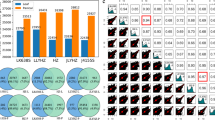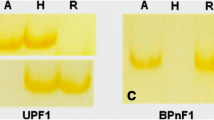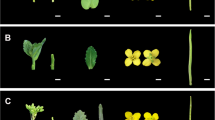Abstract
Heterosis has been widely explored in Larix breeding for more than a century, but the molecular mechanisms underlying this phenomenon remain elusive. In the present study, the genome-wide transcript profiles from two Larix genotypes and their reciprocal hybrids were analyzed using Arabidopsis 70-mer oligonucleotide microarrays. Despite sharing the same two parental lines, one of the hybrids showed obvious heterosis, while the other did not. In total, 1,171 genes were differentially expressed between the heterotic hybrid and its parents, of which 133 genes were nonadditive expression. The number of differentially expressed genes between the non-heterotic hybrid and the parents was 939, but only 54 of these genes were nonadditive expression. Further, gene ontology (GO) and Kyoto encyclopedia of genes and genomes (KEGG) analyses indicated that most of these differentially expressed genes in the heterotic hybrid were associated with several important biological functions such as physiological processes, responses to stimulus, and starch and sucrose metabolism. The reliability of the microarray data was further validated by the Real-time quantitative RT-PCR. A high Pearson linear correlation coefficient value was detected (r = 0.759, P < 0.01). In conclusion, the gene expression profile in the Larix heterotic hybrid was significantly different from that obtained from the non-heterotic hybrid, and more nonadditive differentially expressed genes were detected in the heterotic hybrid, implying that nonadditive effects may be closely associated with the formation of heterosis in the intraspecific Larix hybridization.




Similar content being viewed by others
References
Arnold ML (2004) Natural hybridization and the evolution of domesticated, pest and disease organisms. Mol Ecol 13:997–1007
Guo M, Rupe MA, Yang X, Crasta O, Zinselmeier C, Smith OS, Bowen B (2006) Genome-wide transcript analysis of maize hybrids: allelic additive gene expression and yield heterosis. Theor Appl Genet 113:831–845
Duvick DN (1997) Heterosis: feeding people and protecting natural resources. In: Coors JG, Pandey S (eds) Genetics and exploitation of heterosis in crops. American Society of Agronomy, Madison, pp 19–29
Bruce AB (1910) The Mendelian theory of heredity and the augmentation of vigor. Science 32:627–628
Birchler JA, Auger DL, Riddle NC (2003) In search of the molecular basis of heterosis. Plant Cell 15:2236–2239
Hochholdinger F, Hoecker N (2007) Towards the molecular basis of heterosis. Trends Plant Sci 12:427–432
Fisher RA (1918) The correlation between relatives on the supposition of Mendelian inheritance. Trans Roy soc 52:399–433
Xiao J, Li J, Yuan L, Tanksley SD (1995) Dominance is the major genetic basis of heterosis in rice as revealed by QTL analysis using molecular markers. Genetics 140:745–754
Stuber CW, Lincoln SE, Wolv DW, Helentjaris T, Lander ES (1992) Identification of genetic factors contributing to heterosis in a hybrid from two elite maize inbred lines using molecular markers. Genetics 132:823–839
Yu S, Li JX, Xu CG, Tan YF, Gao YJ, Li XH, Zhang QF, Maroof MAS (1997) Importance of epistasis as the genetic basis of heterosis in an elite rice hybrid. Proc Natl Acad Sci USA 94:9226–9231
Birchler JA, Yao H, Chundalayandi S (2006) Unraveling the genetic basis of hybrid vigor. Proc Natl Acad Sci USA 103:12957–12958
Sun QX, Wu LM, Ni ZF, Meng FR, Wang ZK, Lin Z (2004) Differential gene expression patterns in leaves between hybrids and their parental inbreeds are correlated with heterosis in a diallel cross. Plant Sci 166:651–657
Chen NH, Gao YP, Yang JS, Qian M, Ge KL (1997) Alteration of gene expression in rice hybrid F1 and its parental seedlings. Acta Bot Sin 39:379–382
Wei G, Tao Y, Liu GZ et al (2009) A transcriptomic analysis of superhybrid rice LYP9 and its parents. Proc Natl Acad Sci USA 106:7695–7701
Bao J, Le S, Chen C, Zhang X, Zhang Y, Liu S, Clark T, Wang J, Cao M, Yang H, Wang S, Yu J (2005) Serial analysis of gene expression study of a hybrid rice strain (LYP9) and its parental cultivars. Plant Physiol 138:1216–1231
Vuylsteke M, Eeuwijk FV, Hummelen PV, Kuiper M, Zabeau M (2005) Genetic analysis of variation in gene expression in Arabidopsis thaliana. Genetics 171:1267–1275
Swanson-Wagner RA, Jia Y, Cook R, Borsuk LA, Nettleton D, Schnable PS (2006) All possible modes of gene action are observed in a global comparison of gene expression in a maize F1-hybrid and its inbred parents. Proc Natl Acad Sci USA 103:6805–6810
Ju CL, Zhang F, Gao YF, Zhang W, Yan JB, Dai JR, Li JS (2006) Cloning, chromosome mapping and expression analysis of an R2R3-MYB gene under-expressed in maize hybrid. Mol Biol Rep 33:103–110
Agarwal P, Agarwal PK, Joshi AJ, Sopory SK, Reddy MK (2010) Overexpression of PgDREB2A transcription factor enhances abiotic stress tolerance and activates downstream stress-responsive genes. Mol Biol Rep 37:1125–1135
Gaeta RT, Yoo SY, Pires JC, Doerge RW, Chen ZJ, Osborn TC (2009) Analysis of gene expression in resynthesized Brassica napus allopolyploids using arabidopsis 70 mer oligo microarrays. PLoS One 4:e4760
Fujimoto T, Akutsu H, Kita K, Uchiyama K, Kuromaru M (2004) Variation in the density in hybrid larch (Larix gmelinii var. japonica × L. kaempferi) F1. Abstracts of the 54th Annual Meeting of Japan Wood Research Society (in Japanese), pp 519
Takahashi N, Nishiguchi C (1966) Studies on the resistance of forest trees to the red-backed vole, Clethrionomys rufocanus bedfordiae (Thomas). (2) Relative feeding preference of the vole for seedings of larch F1 hybrids under laboratory conditions. Bull Tokyo Univ Forest 62:173–188 (in Japanese with English summary)
Fukuchi M (1987) A comparison of Kurile larch × Japanese larch with Japanese larch in vole-resistance in a mixed stand. Transactions of the 98th Annual Meeting of the Japanese Forest society (in Japanese), pp 257–258
Oshima T, Hatakeyama S, Kubota Y (1974) Characteristics of generations of hybrid larch. I. Larix gmelinii var japonica × L. kaempferi hybrid larch F1 and their double cross species. Transactions of the 85th Annual Meeting of the Japanese Forest society (in Japanese), pp 169–171
Kaji K, Hatakeyama S, Fujitani M (1974) Characteristics of generations of hybrid larch. II. Larix gmelinii var japonica × L. kaempferi hybrid larch F1 and their back cross species. Transactions of the 85th Annual Meeting of the Japanese Forest society (in Japanese), pp 172–173
Murray MG, Thompson WF (1980) Rapid isolation of high weight plant DNA. Nucleic Acids Res 8:4231–4235
Yang YH, Dudoit S, Luu P, Lin DM, Peng V, Nagi J, Speed TP (2002) Normalization for cDNA microarray data: a robust composite method addressing single and multiple slide systematic variation. Nucleic Acids Res 30:e15
Chen ZJ (2007) Genetic and epigenetic mechanisms for gene expression and phenotypic variation in plant polyploids. Annu Rev Plant Biol 58:377–406
Abdelkhalik AF, Shishido R, Nomura K, Ikehashi H (2005) QTL-based analysis of leaf senescence in an indica/japonica hybrid in rice (Oryza sativa L.). Theor Appl Genet 110:1226–1235
Huang Y, Zhang L, Zhang J, Yuan D, Xu C et al (2006) Heterosis and polymorphisms of gene expression in an elite rice hybrid as revealed by a microarray analysis of 9198 unique ESTs. Plant Mol Biol 62:579–591
Zhang HY, He H, Chen LB, Li L, Liang MZ et al (2008) A genome-wide transcription analysis reveals a close correlation of promoter INDEL polymorphism and heterotic gene expression in rice hybrids. Mol Plant 1:720–731
Li XH, Wei YL, Nettleton D, Brummer EC (2009) Comparative gene expression profiles between heterotic and non-heterotic hybrids of tetraploid Medicago sativa. BMC Plant Biol 9:107
Birchler JA, Riddle NC, Auger DL, Veitia RA (2005) Dosage balance in gene regulation: biological implications. Trends Genet 21:219–226
Yang Y, Wu J, Zhu K, Liu L, Chen F, Yu D (2009) Identification and characterization of two chrysanthemum (Dendronthema × moriforlium) DREB genes, belonging to the AP2/EREBP family. Mol Biol Rep 36:71–81
Zhuang J, Chen JM, Yao QH, Xiong F, Sun CC, Zhou XR, Zhang J, Xiong AS (2010) Discovery and expression profile analysis of AP2/ERF family genes from Triticum aestivum. Mol Biol Rep. doi:10.1007/s11033-010-0162-7
Zhuang J, Xiong AS, Peng RH, Gao F, Zhu B, Zhang J, Fu XY, Jin XF, Chen JF, Zhang Z, Qiao YS, Yao QH (2010) Analysis of Brassica rapa ESTs: gene discovery and expression patterns of AP2/ERF family genes. Mol Biol Rep 37:2485–2492
Nakamura S, Hosaka K (2010) DNA methylation in diploid inbred lines of potatoes and its possible role in the regulation of heterosis. Theor Appl Genet 120:205–214
Takamiya T, Hosobuchi S, Noguchi T, Asai K, Nakamura E, Habu Y, Paterson AH, Iijima H, Murakami Y, Okuizumi H (2008) Inheritance and alteration of genome methylation in F1 hybrid rice. Electrophoresis 29:4088–4095
Zhang MS, Yan HY, Zhao N, Lin XY, Pang JS, Xu KZ, Liu LX, Liu B (2007) Endosperm-specific hypomethylation and meiotic inheritance and variation of DNA methylation level and pattern in sorghum (Sorghum bicolor L.) inter-strain hybrids. Theor Appl Gene 115:195–207
Lauria M, Rupe M, Guo M, Kranz E, Pirona R, Viotti A, Lund G (2004) Extensive maternal DNA hypomethylation in the endosperm of Zea mays. Plant Cell 16:510–522
Ni ZF, Kim ED, Ha M, Lackey E, Liu JX, Zhang YR, Sun QX, Chen ZJ (2008) Altered circadian rhythms regulate growth vigor in hybrids and allopolyploids. Nature 457:327–331
Acknowledgments
Firstly, we thank the anonymous reviewers for critical reading of the manuscript. We are also grateful to Dr. Liwang Qi, Chinese Academy of Forestry, Beijing, China, for kindly providing the materials of Larix kaempferi (Lamb.). This work was carried out with the financial support from The National Key Basic Research Program (N0. 2009CB119105) and The National Natural Science Foundation of China and Tianjin (N0. 10JCZDJC17900 and N0. 07JCYBJC11700).
Author information
Authors and Affiliations
Corresponding author
Rights and permissions
About this article
Cite this article
Li, A., Fang, MD., Song, WQ. et al. Gene expression profiles of two intraspecific Larix lines and their reciprocal hybrids. Mol Biol Rep 39, 3773–3784 (2012). https://doi.org/10.1007/s11033-011-1154-y
Received:
Accepted:
Published:
Issue Date:
DOI: https://doi.org/10.1007/s11033-011-1154-y




